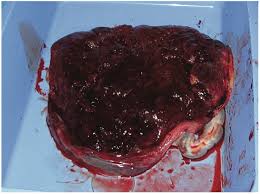Managing Placental Abruption: Treatment Options and Care Guidelines
Placental abruption is a serious pregnancy complication in which the placenta partially or completely separates from the uterus before delivery. This separation can disrupt the normal supply of oxygen and nutrients to the baby, potentially leading to a premature delivery and even death. It affects approximately 1 in 150 pregnancies and can cause severe bleeding, low birth weight, premature birth, and even fetal death. The exact cause of placental abruption is unknown, but it is often associated with trauma to the abdomen during pregnancy or a sudden increase in blood pressure. If detected early enough, doctors may be able to treat placental abruption and limit its potential complications. However, if left untreated, placental abruption can lead to severe complications for both mother and baby such as severe maternal hemorrhage, hypovolemic shock (low blood volume), organ damage due to oxygen deprivation, preterm labor or delivery, and even fetal death if the placenta detaches completely from the uterus. Please keep reading for details on the following topics:
Risk factors for placental abruption
Causes of placental abruption
Symptoms of placental abruption

Types of Placental Abruption
- Partial Abruption: Only part of the placenta detaches.
- Complete Abruption: The entire placenta detaches.
- Concealed Abruption: Bleeding is trapped between the placenta and the uterine wall, not visible externally.
- Revealed Abruption: Bleeding is visible externally.
Risk factors for placental abruption
High levels of stress or anxiety
Pre-existing conditions like diabetes
The presence of certain infections
Placental abruption in a prior pregnancy
Advanced maternal age (woman is over 35 years old)
Trauma to the abdomen during pregnancy (e.g., car accidents or falls)
Hypertension (High blood pressure) or preeclampsia
Smoking or substance abuse (e.g., cocaine use)
Premature rupture of membranes (PROM)
Symptoms of placenta previa
It is important to know when to seek urgent medical care, as delaying appropriate treatment can lead to further health complications. If you experience any of the following symptoms, you should seek medical help immediately. If you have any doubts about whether you should seek medical care, it is always better to err on the side of caution and consult with your doctor.
The woman may experience vaginal bleeding (may not always be present, especially in concealed abruption)
Severe abdominal pain
Frequent or Rapid contractions
Uterine tenderness
Signs of shock such as pale skin and dizziness
Signs of fetal distress (e.g., abnormal heart rate patterns)
Complications
- For the mother:
- Severe hemorrhage
- Blood clotting issues (DIC – Disseminated Intravascular Coagulation)
- Need for emergency hysterectomy
- For the baby:
- Preterm birth
- Growth restriction
- Stillbirth
Diagnosis
- Physical Examination: Assess symptoms like tenderness and bleeding.
- Ultrasound: May show retroplacental bleeding but not always definitive.
- Blood Tests: To check for anemia or clotting issues.
- Fetal Monitoring: To assess fetal distress.
If diagnosed early on with proper management techniques like bed rest in a hospital setting and careful monitoring of vital signs, many patients are able to avoid more serious complications related to placental abruption. However, depending on the severity of the case an emergency cesarean section may be necessary in order to deliver the baby safely. Treatment options will also depend on how far along the pregnancy is since delivering too early carries its own set of risks for both mother and infant.
Treatment
The treatment depends on the severity of the abruption, gestational age, and the condition of the mother and baby:
- Mild cases (minor abruption):
- Hospital monitoring
- Bed rest
- Medications to manage symptoms
- Severe cases:
- Emergency delivery (often by cesarean section)
- Blood transfusions for the mother if needed
- Stabilizing the mother is the first priority.
Prevention
While it’s not always preventable, the following can reduce risks:
- Regular prenatal care
- Controlling blood pressure
- Avoiding smoking, alcohol, and illicit drugs
- Using seatbelts properly to reduce trauma risks
Disclaimer: The information provided in this content is for general informational purposes only. It is not intended as medical or healthcare advice, diagnosis, or treatment. Always seek the advice of a qualified healthcare professional with any questions you may have regarding a medical condition or healthcare decisions.

